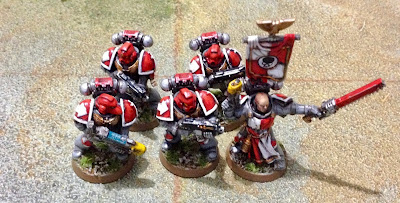I have now completed my second 6x6 game challenge using Scenario 12 from One-Hour Wargames - "an unfortunate oversight" for the game setup. To cater for some unit movement range the depth of the map was stretched placing the objective a communications array further away.
Narrative to the game...
Having suffered a setback when ambushed while advancing towards the mining colony X374 on the world of Dranus. The Space Marine command assembled another force with ordered to push on towards X374. They found a Necron force encamped around the colony buildings. Under cover of the atmosphere storms which typically ravage planet an advance party of scouts identified a suitable and undefended crossing over a lava river.
Some units involved...
Some example units with there stats for the rules used (see tab at top of blog) and an opportunity for some close up pictures of the models themselves.
Dreadnought
Moves 1 square, attack range 3 squares, armour is 11 and has a power weapon.
Landspeeder(s)
Moves 3 sqaures, attack range 2 squares, armour is 11 and one had a blast weapon and the other an assault (rapid fire) weapon.
Scouts
Moves 1 square, attack range 2 squares, armour is 7 and with sniper rule.
Psychics
Moves 1 square, attack range 2 squares, armour is 9 and with psychic attack rule (3 squares).
Tactical Squad (command section)
Moves 1 square, attack range 2 squares, armour is 8, with veteran and power attack rule.
Tactical Squad (support section)
Moves 1 square, attack range 3 squares, armour is 8 and with power attack rule.
Terminator Squad (leader)
Moves 1 square, attack range 2 squares, armour is 9 and with blast attack rule.
Assault Squad
Moves 3 squares, attack range 1 square, armour is 8 and with flamer attack rule.
The game in pictures...
 |
| Game setup with the Space Marine objective (communications array) in the foreground |
 |
| Necrons quickly redeploy units to defend the communications array |
 |
| First Space Marine casualties as their support arrives |
 |
| The first wave of the assault begins |
 |
| Necrons hold their ground while the Space Marines regroup |
 |
| Psychic unit moves towards the buildings to hold Necron units there |
 |
| Accurate Space Marine shooting allows a final and successful assault |
Summary of the game
The Space Marine attack was a bit slow off the mark, but did capture the objective in the end. The two Landspeeders proved to be very useful after their destruction by providing cover for the advancing units behind them.
A couple of attacks on the colony building complex by the space marine tactical squad, while unsuccessful, were sufficient to occupy the Necron units and stop them from moving to defend the communications array objective.
With a couple of successful attack dice rolls at the end by the Necrons could have easily swayed the fate of the game to them. So a close game and played to a conclusion in 30 minutes. I am quite liking these rule mechanisms from the on Tank on Tank board game and the speed at which they play, which seems quite appropriate for units armed with powerful weapons and speedy vehicles.
Most rule mechanisms are working. Troop units suffer badly when caught in open and try to move from terrain to terrain. Failed assaults are punished as attacking units get left in exposed in the open.
A couple of modifications to the rules for the next game.
- Psychic range is always 2 squares for powerful psychic and 1 square for weaker psychics.
- I am going to try a D12 rather than a 2D6 when making attacks to even out the changes of a hit.
Unit of the game is going to the Dreadnought who's supporting attacks reduced Nercon units to smouldering wrecks towards the end of the game and paving the way to a Space Marine victory.























































